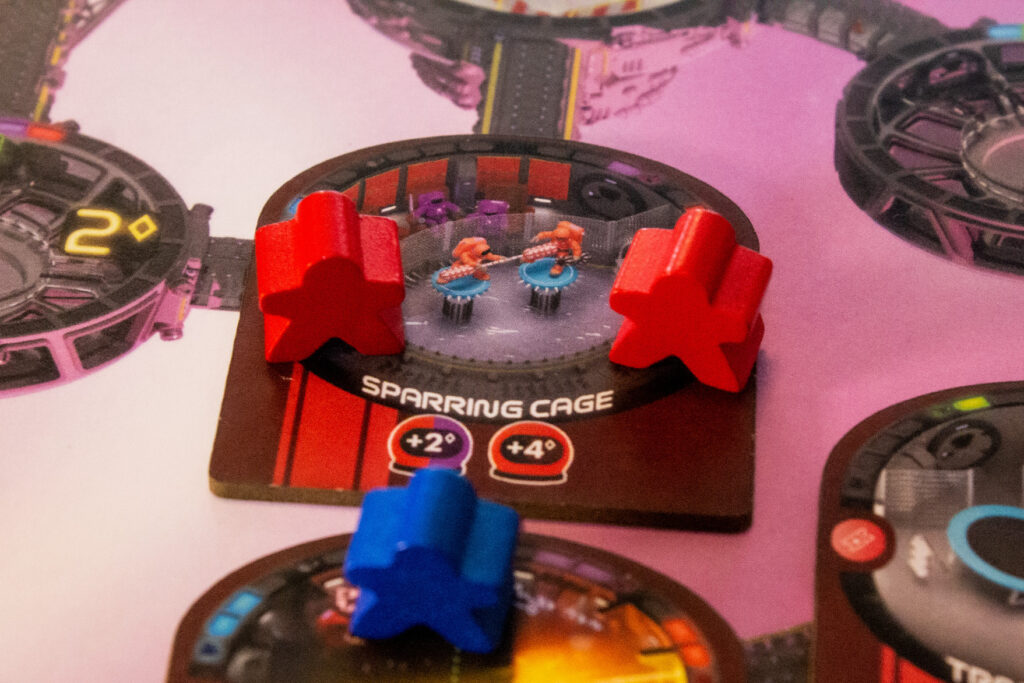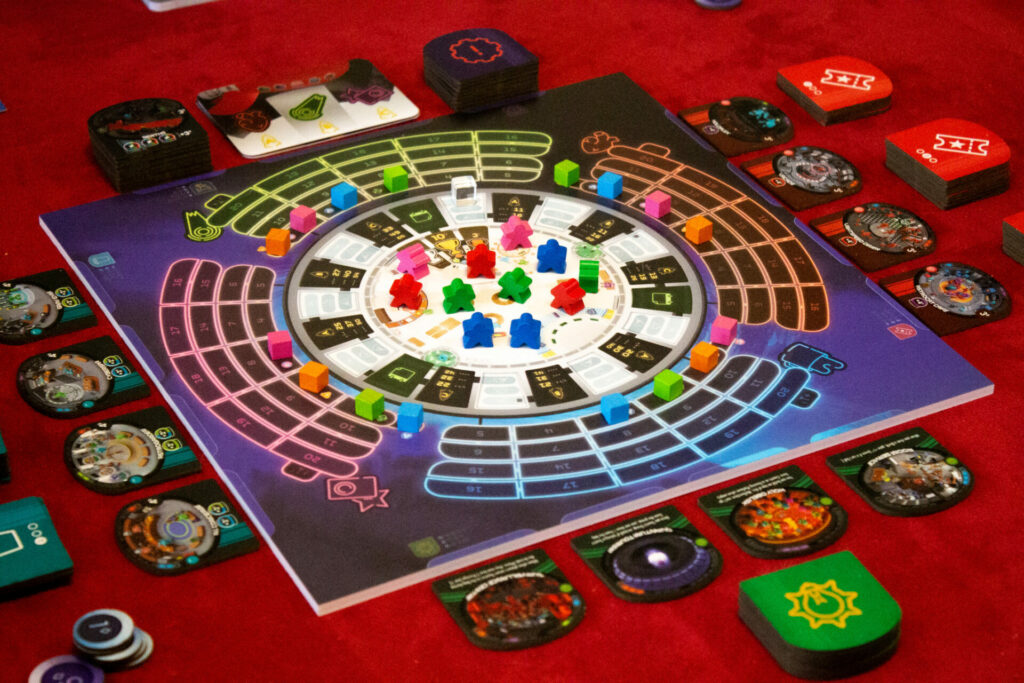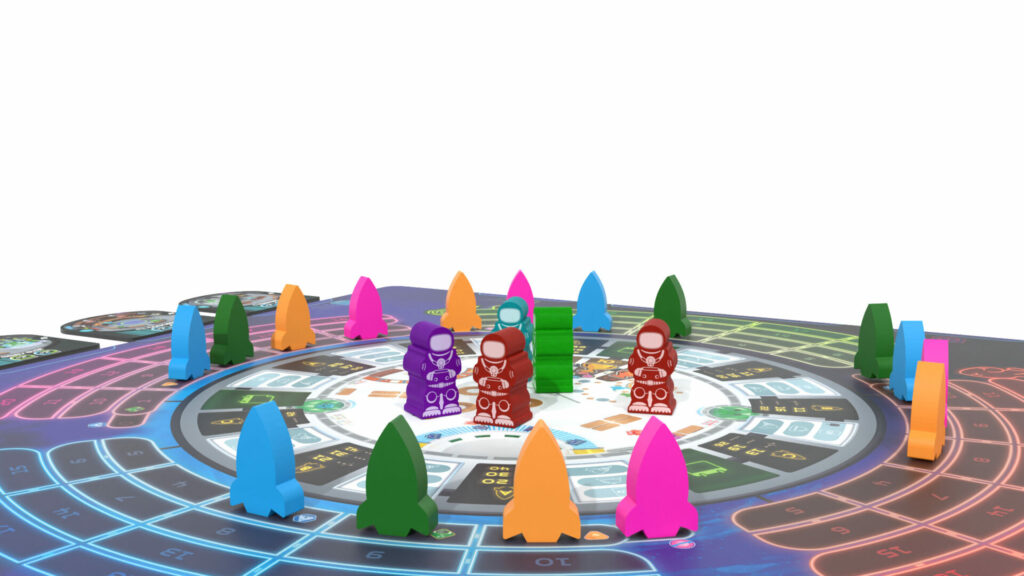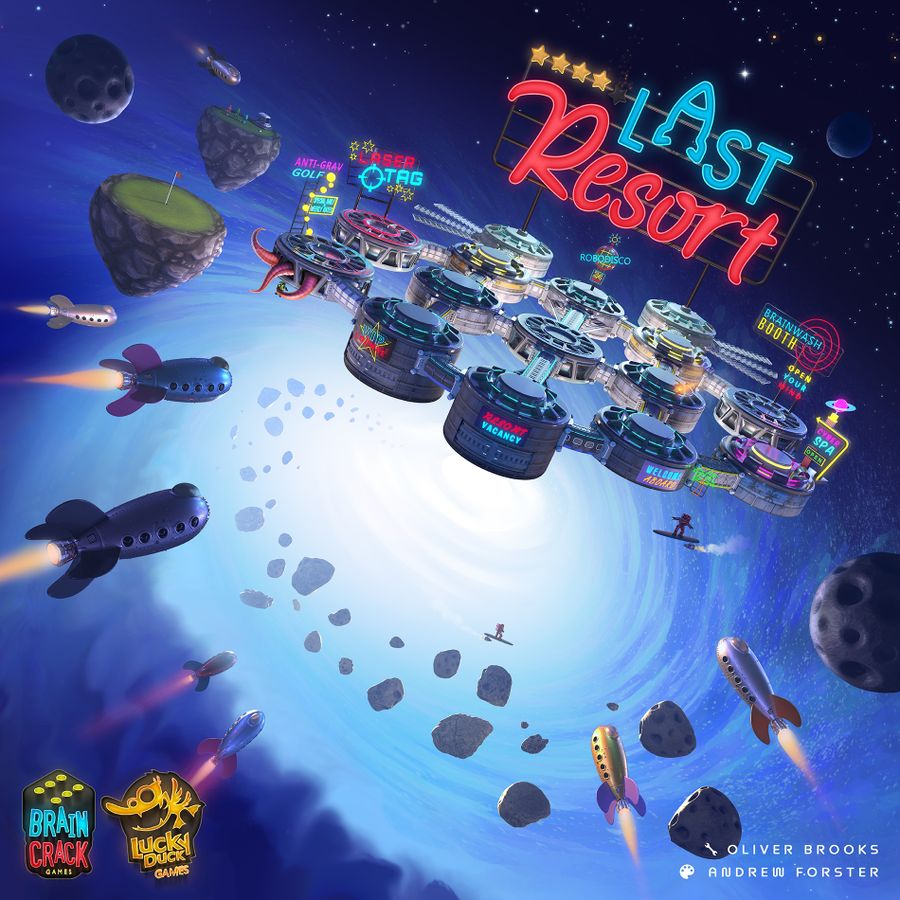Disclaimer: I’ve been playing with a prototype copy of the game. Components, artwork, and rules are all subject to change before release.
When I was a kid, I loved the Hitchhiker’s Guide to the Galaxy series of books. The one I remember most is The Restaurant at the End of the Universe, and I always had a mental image of what it looked like. I was stunned when I first saw the artwork created for the box of Last Resort, because it’s almost identical to the scene I’d imagined from the book.
As it happens, you’d probably expect a decent restaurant in the setting for this game. You play as entrepreneurs who have bought derelict space stations, and aim to turn them into the swankiest holiday resorts in the cosmos. This isn’t your Airbnb style holiday, think of it more like Space Vegas. (note to self – trademark ‘Space Vegas’, it sounds awesome). If you’ve enjoyed the tile-grabbing, ship-destroying mayhem of Galaxy Trucker, and wondered what the pilots do after retirement, I reckon it’s creating these resorts.
Castles of Betelgeuse
The first game Last Resort reminded me of is Castles of Burgundy. It’s something to do with the market of tiles in the middle of the table, and then buying the tiles and adding them to my own little board, and getting very attached to my little space station. The gameplay is pretty different however. The tiles you add to your board are rooms in your resort, and each can support a certain number of tourists. At the end of each round, once you’ve added a new room to your board, a busload (rocketload?) of tourists turn up in the middle of the table. Players take turns taking one, and adding it to one of their rooms.

Think of it like landing in some far-flung country for your summer holiday, then having reps from different places trying to get you to come and see their attraction. Except in Last Resort you won’t be taking the long way back, stopping at their cousin’s shop to sell you a new wallet.
Each tourist wants a particular type of vacation, and you can tell which type from their colour. If you want to house the red thrill-seekers, you need rooms which they’ll want to use, such as the VRcade. The blues just want to chill-out, so might prefer a Cyberspa. The thing is, you don’t know what type of tourists will arrive, as they’re drawn at random from a bag. Go all-in on one type of place, or try to have a little bit of everything? That’s the sort of choice you have to make from the outset.
Checking-out, sir?
One of the big things Last Resort has going for it is how little you have to maintain, and the relatively small number of decisions you need to make. You’ve only got four advert cards in your hand at the start of each year, and then get to play three of them. The cards decide which guests you’re going to boot-out and collect money from, and what type of tile you’re going to build. That level of relative simplicity is perfect for the game.
One of my favourite things is when the new arrivals land each round. You take big fistfuls of astronauts out of a bag and dump them on the middle board. Everyone takes turns to choose one and add it to their resort, and it goes round and round like that, but the competition for pieces is great fun. Sometimes you’ll choose to take a visitor just because it’s the last in that colour, and you know your neighbour wanted it. Mostly people call that indirect interaction, but I prefer to think of it as optimal passive-aggression. If you’re forced to take visitors you can’t accommodate, they get ejected into space and you lose position on one of the four influence tracks.

I felt oddly uneasy about shoving people out of the airlock when I don’t have room for them. For a game of silly retro-futuristic rockets and tongue-in-cheek humour, killing tourists felt out of place. I’d have liked to seen them ‘go back on the rocket’ or something. I think I’m getting soft in my old age.
Light speed
If you’ve played any of Braincrack’s ‘City’ trio of games (Ragusa and Venice reviewed here, Florence on the way), there’s likely to be two things that strike you about Last Resort. Firstly, it feels like a Braincrack game. There’s a Euro game here with some indirect interaction, a lot of competition for things, and a familiar round structure. The second thing you might notice is that it feels much lighter in complexity than the three games I just mentioned. This isn’t a cause for concern, it’s just different. It’s really nice to see the publisher going with a very different setting and take on something much more light-hearted. A lot of people only know them for the more serious, historical City games, but this one feels like a step back to the kind of game Dead and Breakfast was, before those.

Being a lighter game, it’s a much easier teach, and it’s a game that plays out pretty quickly too. Even with a full complement of four players, a game of Last Resort shouldn’t take more than an hour. It’s a small, but important detail, for non-gamers. It’s a great game to start or end a games night with. There’s a decent level of strategy in the game, but not too many decisions to make, which helps the game tick along at a good pace. The theme and the bright colours are an easy sell to younger players, and those friends whose eyes roll back into their head when you suggest playing ‘one of your games’.
Final thoughts
Last Resort is shaping up to be a really good game. The prototype copy I’ve been playing with has wooden meeples and cubes, which will be replaced with little astronauts and rockets respectively. These additions will really help the table presence, and again, encourage non-gamers to engage with it. I really appreciate how simple the teach and iconography are, and I love playing a game with this lighter level of strategy for a change.

My son enjoyed it, and even my non-gamer friends were willing to at least sit down and play it with me. Believe me when I tell you that that’s a big deal. As a whole, Last Resort is a very different kind of game when compared to the likes of Ragusa. It’s not as heavy, and the biggest obvious departure is the move away from a shared board to play on. Ragusa, Venice, and Florence all use a shared main board, where you spend the majority of the game putting more and more things onto it. This keeps the player interaction in those games high, which is great if that’s what you’re after, but not everybody is.
Last Resort is perfect for introducing people to the ideas of tile-placement and drafting. By playing with your own board, and only ever taking things from the middle of the table, the only real interaction is passive. It’s taking things that maybe someone else wanted. I’d prefer to play Venice if I was given the choice, but that’s because I love thinking lots of moves ahead, and I like second guessing what I’m going to be competing for. For fans of light-to-medium games, however, Last Resort is great. I love the theme, I love that it doesn’t take itself seriously, and I love the fact it doesn’t swamp a table. Snappy, engaging, cosmic fun for all – great stuff.
The Kickstarter campaign should go live in early 2022. You can find out more and back it here – bit.ly/lastresort-ks
Preview copy kindly provided by Braincrack Games. Thoughts and opinions are my own.

Last Resort (2022)
Designer: Oliver Brooks
Publishers: Braincrack Games, Lucky Duck Games
Art: Andrew Forster, Dann May, Greg May
Players: 1-4
Playing time: 45-60 mins
